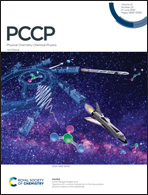Solvation effects on wavenumbers and absorption intensities of the OH-stretch vibration in phenolic compounds – electrical- and mechanical anharmonicity via a combined DFT/Numerov approach†
Abstract
Previous measurements of fundamental, first-, second- and third overtones of the OH-stretching vibration of phenol and 2,6-difluoro-phenol by use of visible (Vis), near-infrared (NIR) and infrared (IR) spectroscopy revealed an oscillating pattern in the intensity quotient between the two kinds of solvents, carbon tetrachloride and n-hexane, upon increase of the vibrational quantum number, which could not be reproduced utilizing quantum mechanical calculations in implicit solvation. In the present study this phenomenon was successfully explained for the first time, employing an explicit consideration of solute–solvent interactions in combination with modern grid-based methods to solve the time-independent Schrödinger equation. The capabilities of this framework of (i) not requiring any assumptions on the form of the resulting wave function, (ii) focusing the description on the vibrational mode of interest and (iii) taking solute–solvent interactions explicitly into account are a particularly lucid example of the advantages in applying state-of-the-art approaches in investigations of challenging vibrational quantum problems. The property of grid-based methods being directly applied onto any given potential energy grid together with point (i) enable to analyse the impact of mechanical- and electrical anharmonicity independently. Especially the detailed investigation of the latter contribution when moving from a harmonic to an anharmonic potential in conjunction with the explicit consideration of solvent effects at the example of an actual chemical system (i.e. not discussing these effects employing mere model potentials) demonstrate the manifold benefit achieved using the applied DFT/Numerov strategy.



 Please wait while we load your content...
Please wait while we load your content...